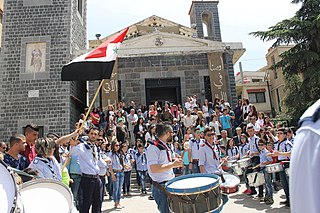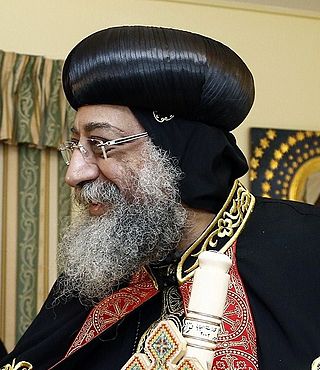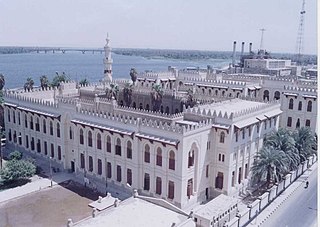Related Research Articles

The Coptic Orthodox Church,, also known as the Coptic Orthodox Patriarchate of Alexandria, is an Oriental Orthodox Christian church based in Egypt. The head of the church and the See of Alexandria is the pope of Alexandria on the Holy Apostolic See of Saint Mark, who also carries the title of Father of fathers, Shepherd of shepherds, Ecumenical Judge and the 13th among the Apostles. The See of Alexandria is titular. The Coptic pope presides from Saint Mark's Coptic Orthodox Cathedral in the Abbassia District in Cairo. The church follows the Coptic Rite for its liturgy, prayer and devotional patrimony. Adherents of the Coptic Orthodox Church make up Egypt's largest and most significant minority population, and the largest population of Christians in the Middle East and North Africa (MENA). They make up the largest percentage of approximately 20 million Christians in Egypt

Mark the Evangelist also known as John Mark or Saint Mark, is the person who is traditionally ascribed to be the author of the Gospel of Mark. Modern Bible scholars have concluded that the Gospel of Mark was written by an anonymous author rather than an identifiable historical figure. According to Church tradition, Mark founded the episcopal see of Alexandria, which was one of the five most important sees of early Christianity. His feast day is celebrated on April 25, and his symbol is the winged lion.

The Egyptian language or Ancient Egyptian is an extinct Afro-Asiatic language that was spoken in ancient Egypt. It is known today from a large corpus of surviving texts, which were made accessible to the modern world following the decipherment of the ancient Egyptian scripts in the early 19th century. Egyptian is one of the earliest known written languages, first recorded in the hieroglyphic script in the late 4th millennium BC. It is also the longest-attested human language, with a written record spanning over 4,000 years. Its classical form is known as “Middle Egyptian.” This was the vernacular of the Middle Kingdom of Egypt, and it remained the literary language of Egypt until the Roman period. By the time of classical antiquity, the spoken language had evolved into Demotic, and by the Roman era it had diversified into the Coptic dialects. These were eventually supplanted by Arabic after the Muslim conquest of Egypt, although Bohairic Coptic remains in use as the liturgical language of the Coptic Church.

The Coptic calendar, also called the Alexandrian calendar, is a liturgical calendar used by the Coptic Orthodox Church and also used by the farming populace in Egypt. It was used for fiscal purposes in Egypt until the adoption of the Gregorian calendar on 11 September 1875. This calendar is based on the ancient Egyptian calendar. To avoid the calendar creep of the latter, a reform of the ancient Egyptian calendar was introduced at the time of Ptolemy III which consisted of adding an extra day every fourth year. However, this reform was opposed by the Egyptian priests, and the reform was not adopted until 25 BC, when the Roman Emperor Augustus imposed the Decree upon Egypt as its official calendar. To distinguish it from the Ancient Egyptian calendar, which remained in use by some astronomers until medieval times, this reformed calendar is known as the Coptic or Alexandrian calendar. Its years and months coincide with those of the Ethiopian calendar but have different numbers and names.

Copts are a Christian ethnoreligious group indigenous to North Africa who have primarily inhabited the area of modern Egypt since antiquity. They are the largest Christian denomination in Egypt and the Middle East, as well as in Sudan and Libya. Copts in Egypt account for roughly 5–15 percent of the Egyptian population; Copts in Sudan account for 1 percent of the Sudanese population, while Copts in Libya similarly account for 1 percent of the Libyan population.

The Nag Hammadi library is a collection of early Christian and Gnostic texts discovered near the Upper Egyptian town of Nag Hammadi in 1945.

Our Lady of Zeitoun, also known simply as El-Zeitoun, Zeitun or rarely Our Lady of Light, was a mass Marian apparition that was reported to have occurred in the Zeitoun district of Cairo, Egypt, during a period of about 3 years beginning on 2 April 1968.
Pope Avilius of Alexandria, was the 3rd Patriarch of Alexandria.
Pope Julian (Yulianus) of Alexandria was the 11th Pope and Patriarch of Alexandria.

Arab Christians are ethnic Arabs, Arab nationals, or Arabic-speakers who follow Christianity. The number of Arab Christians who live in the Middle East was estimated to be between 10 and 15 million. Arab Christian communities can be found throughout the Arab world, but are concentrated in the Eastern Mediterranean region of the Levant and Egypt, with smaller communities present throughout the Arabian Peninsula and North Africa.
Miaphysitism is the Christological doctrine that holds Jesus, the "Incarnate Word, is fully divine and fully human, in one 'nature' (physis)." It is a position held by the Oriental Orthodox Churches and differs from the Chalcedonian position that Jesus is one "person" in two "natures", a divine nature and a human nature (dyophysitism).

The British Orthodox Church (BOC), formerly the Orthodox Church of the British Isles, is an independent Oriental Orthodox church.

The pope, also known as the Bishop of Alexandria or the Coptic pope, is the leader of the Coptic Orthodox Church, with ancient Christian roots in Egypt. The primacy in the Coptic pope, similar to the Catholic belief in the Bishop of Rome as successor to Saint Peter, is rooted in his role as successor to Saint Mark. The current holder of this position is Pope Tawadros II, who was selected as the 118th pope on November 18, 2012.

Asyut is the capital of the modern Asyut Governorate in Egypt. It was built close to the ancient city of the same name, which is situated nearby. The modern city is located at 27°11′00″N31°10′00″E, while the ancient city is located at 27°10′00″N31°08′00″E. The city is home to one of the largest Coptic Catholic churches in the country.

The First Epistle of Clement is a letter addressed to the Christians in the city of Corinth. Based on internal evidence some scholars say the letter was composed some time before AD 70, but the common time given for the epistle's composition is at the end of the reign of Domitian. It ranks with Didache as one of the earliest, if not the earliest, of extant Christian documents outside the traditional New Testament canon. As the name suggests, a Second Epistle of Clement is known, but this is a later work by a different author. Part of the Apostolic Fathers collection, 1 and 2 Clement are not part of the canonical New Testament.

Christianity is the second largest religion in Egypt. The vast majority of Egyptian Christians are Copts. As of 2019, Copts in Egypt make up approximately 10 percent of the nation's population, with an estimated population of 9.5 million or 10 million. In 2018, approximately 90% of Egyptian Christians were Coptic Orthodox.

The Oriental Orthodox Churches are Eastern Christian churches adhering to Miaphysite Christology, with approximately 50 million members worldwide. The Oriental Orthodox Churches adhere to the Nicene Christian tradition. Oriental Orthodoxy is one of the oldest branches in Christianity.
The Islamization of Egypt occurred after the 7th century Arab conquest of Egypt, in which the Islamic Rashidun Caliphate seized control of Egypt from the Christian Byzantine Empire. Egypt and other conquered territories in the Middle East underwent a large scale gradual conversion from Christianity to Islam, accompanied by jizya for those who refused to convert. Islam became the dominant faith by the 10th to 12th centuries, and Arabic replaced Coptic as the vernacular language and Greek as the official language.
The ancient church orders form a genre of early Christian literature, ranging from 1st to 5th century, which has the purpose of offering authoritative "apostolic" prescriptions on matters of moral conduct, liturgy and Church organization. These texts are extremely important in the study of early liturgy and served as the basis for much ancient ecclesiastical legislation.
References
- 1 2 Gawdat Gabra (26 October 2009). The A to Z of the Coptic Church. Scarecrow Press. p. 71. ISBN 978-0-8108-7057-4 . Retrieved 15 May 2020.
- ↑ Jim Cole; Tony Stankus (25 February 2014). Journals of the Century. Routledge. p. 176. ISBN 978-1-317-72014-0 . Retrieved 18 October 2016.
- ↑ Coptic Church Review
- ↑ Coptic Church review. OCLC 6970380 . Retrieved 18 October 2016– via WorldCat.